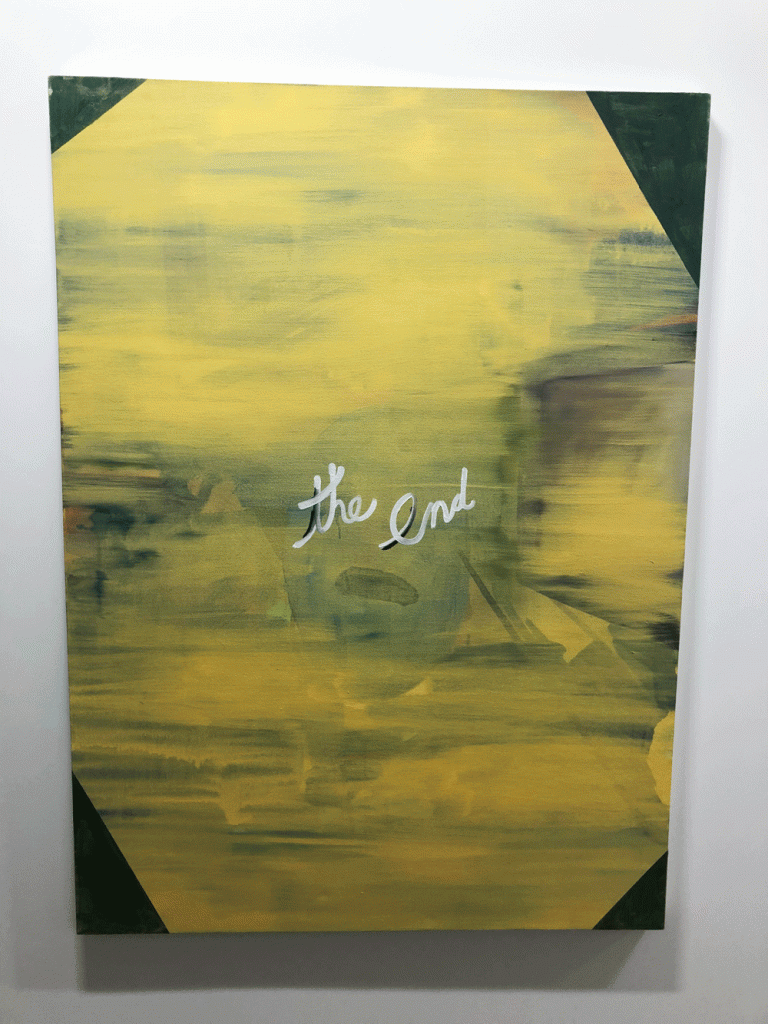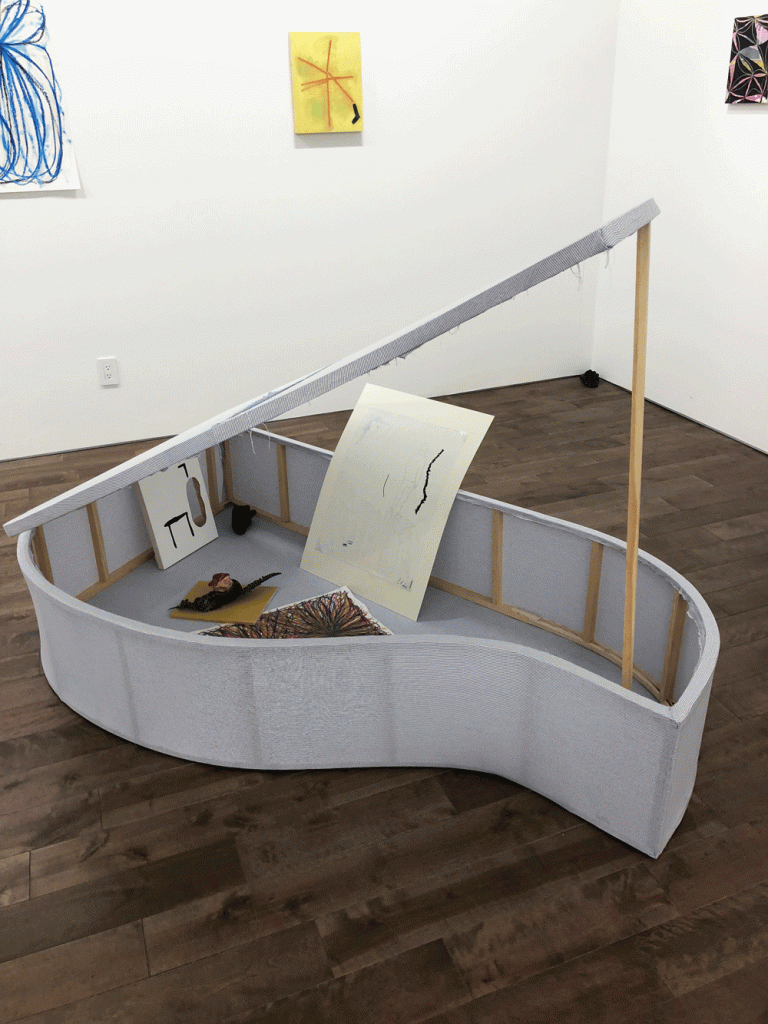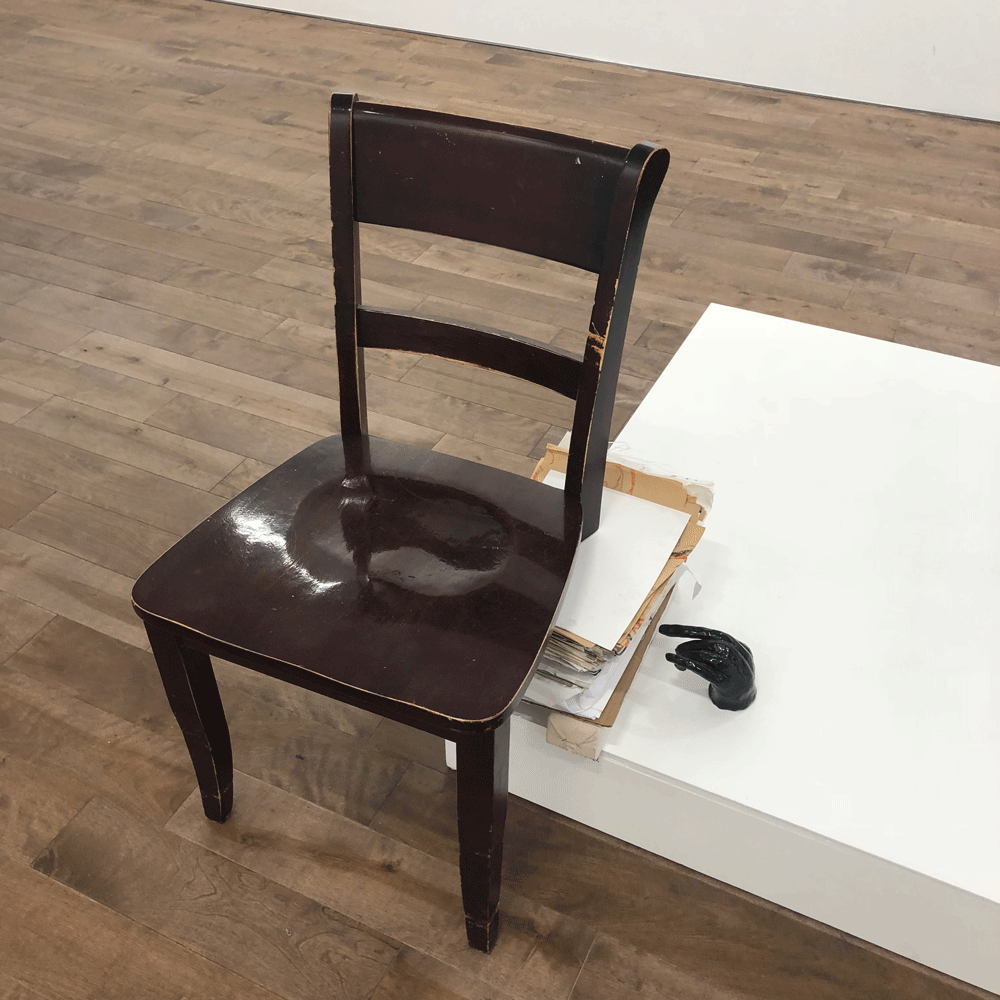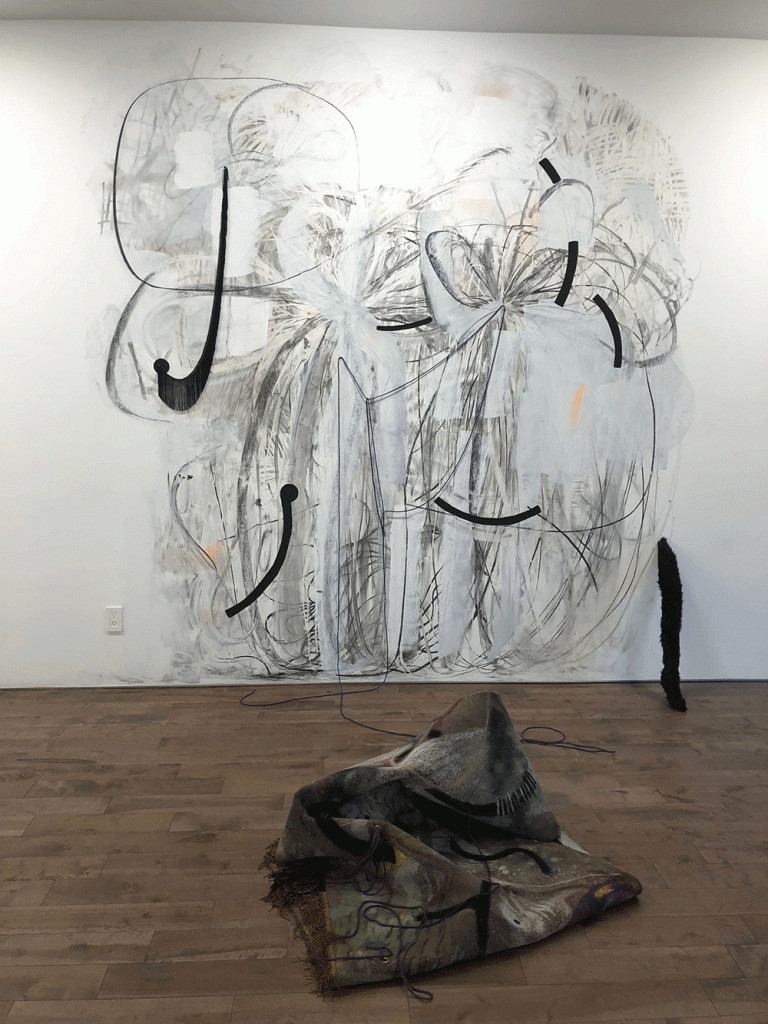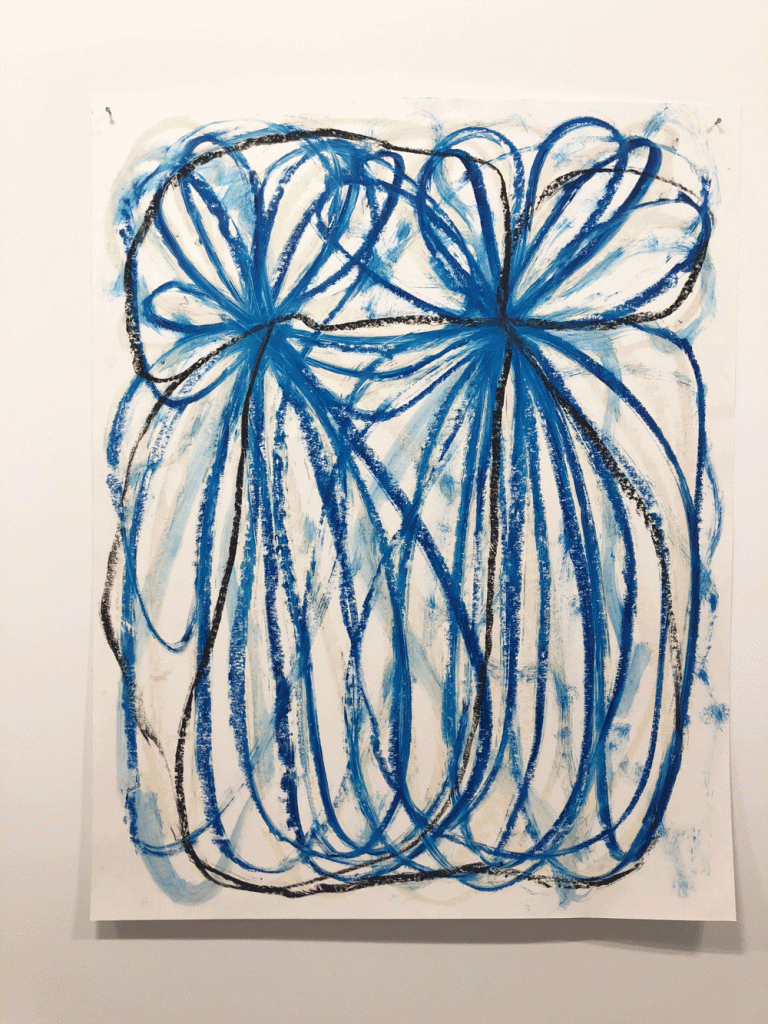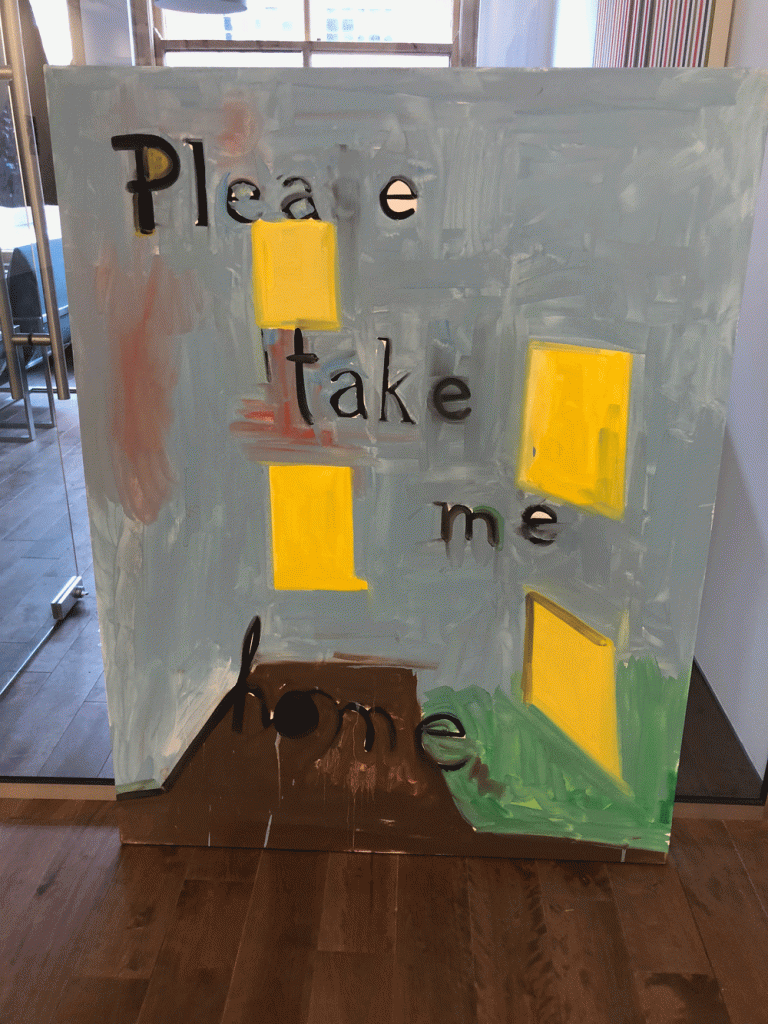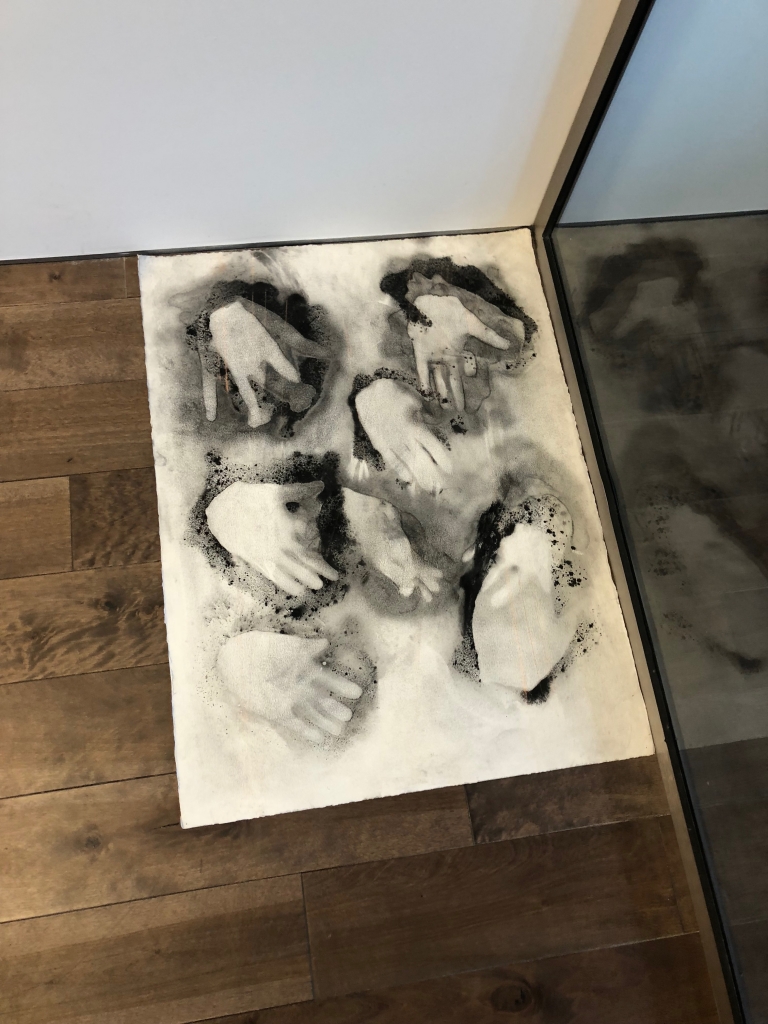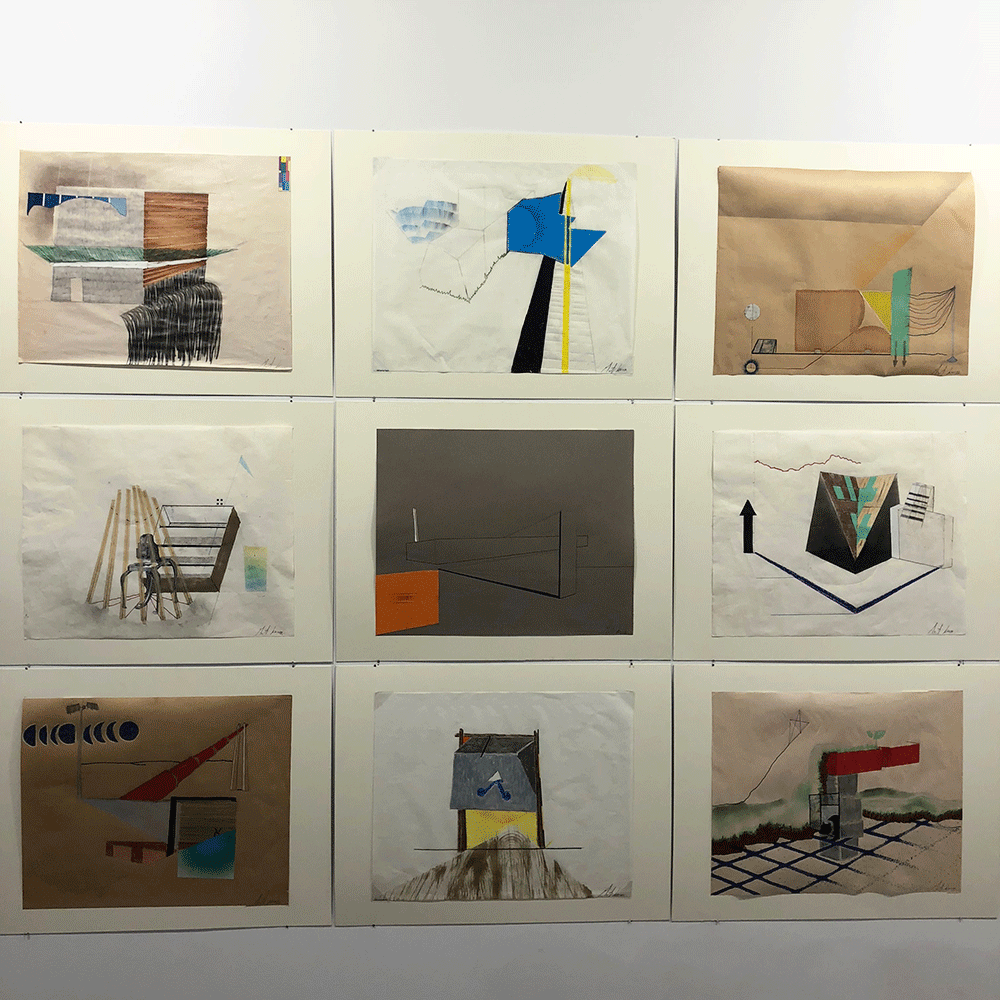September 21- October 7, 2023
Liza Sokolovskaya’s first solo exhibition, It is the Closest We Will Be, is a humorous and poignant exploration of materials and memories, featuring oil paintings, textile works, acrylic skins, small sculptures, and papier maché objects. The concept for the installation is an artist’s live-work studio, the environment filled with images, detritus, and treasures from Sokolovskaya’s life, sometimes autobiographical, and at other times fictional. The works in this show are strongly suggestive of the idiosyncrasies of memory, its permeability, the way it fades and is distorted. Certain things, people, places, and questions haunt us. The show is focused on Sokolovskaya’s experience as an immigrant and her migratory life, travelling from Uzbekistan to Montreal, to New York, and then returning home. This show is a sort of homecoming as she was raised in Montreal, but left for several years to study in New York City. Sokolovskaya was born in 1989 in Tashkent, Uzbekistan, and her family immigrated to Montreal when she was a child.
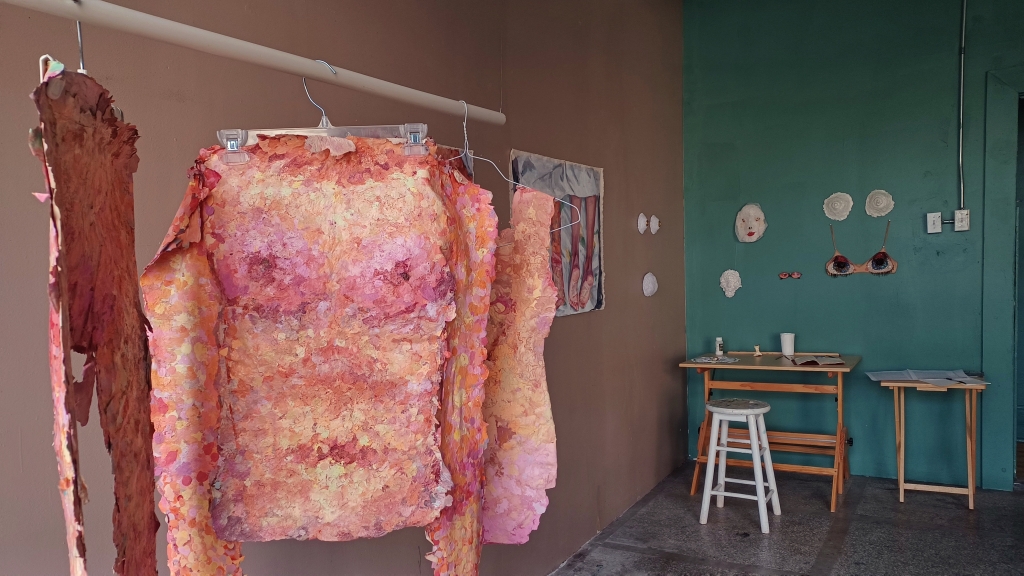
Sokolovskaya moved to New York City in 2016 when she began studying at the New York Academy of Art. NYAA has an esteemed MFA program, and is known for classes which focuses on technique and working from live models. After graduating, Sokolovskaya maintained a strong studio practice, during which she has explored painting pleinair painting, oil painting on mylar, textile art, making shaving cream monotypes, and more. Her experience at the prestigious NYAA refined her painting practice, but also seriously loosened her up and gave her oeuvre a sense of cohesion. She learned how to paint the figure from life, to work more quickly, and to paint more boldly with larger brushes. The result is that her paintings are more dynamic, immediate and approachable and they mesh successfully with her more experimental and playful pieces.
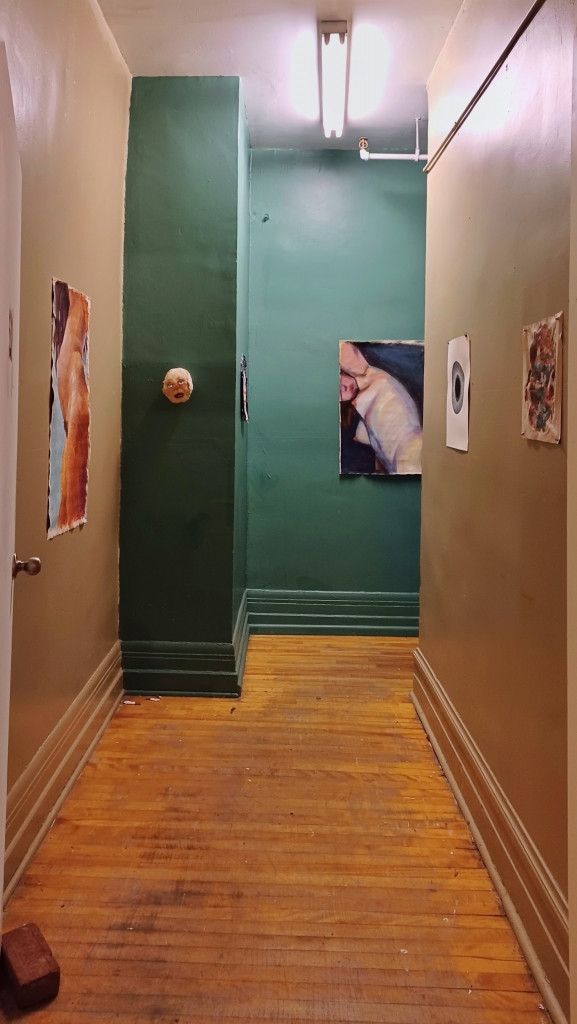
When you enter It is the Closest We Will Be, you start with a mix of new and old, prints, paintings, and two fibre works, on the whimsically-painted early 20th century walls. The choices make more sense as you take in the entire exhibition. To our left, we see the distended torso of a woman with long brown hair hanging in tendrils like Medusa’s snakes, a fragment of the artist. We cannot see her face, but this oil and oil pastel painting’s title, Disease or Desire, asks the question most on the viewer’s mind. Golden Tooth, Beaded Eyes a stuffed and beaded textile piece that looks like a mask almost seems to mock or threaten us as we approach, like a gargoyle warding off those who may not appreciate the show with its bared beaded teeth and beady eyes. On the walls of the hallway leading to the main exhibition room, we see two more fresh oil paintings from this year. Curved, in cool violet, blue, and lemon yellow, is a self-portrait nude torso that shows a body that seems to bend in a stretch, or perhaps just an odd position as she uses the selfie camera on her phone. Also pinned up in the hall is a painting of the arm of the artist’s father painted lovingly and softly against the luminous folds of a pink duvet. The works in this transitional space set the mood for self-reflection and family history. A bright abstract acrylic skin shows us that things are about to get weird.
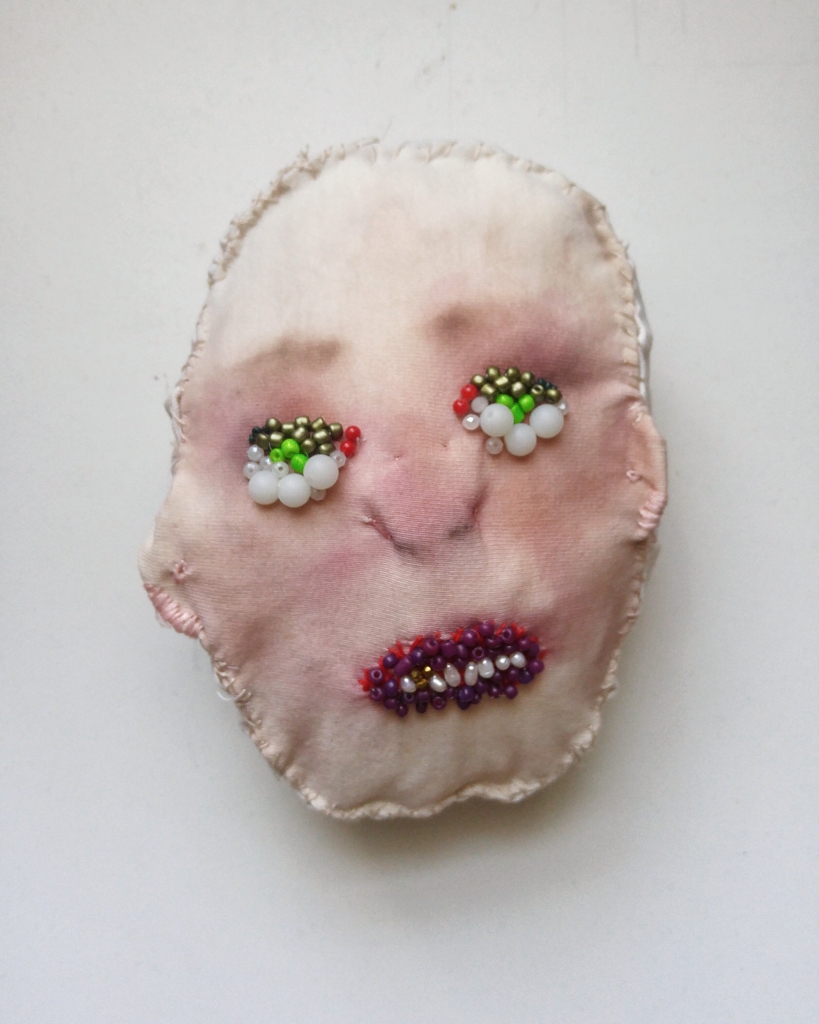
Entering the unconventional main exhibition space, the viewer is probably unsure whether they are intruding upon a private studio, as there is an odd combination of coloured walls, paintings on the wall, odd works scattered about, furniture, and objects which are not normally seen in an art gallery. In the corner to the right of the entrance is an artist’s working station. On a drawing table are a sketchbook, a few art supplies, and a papier mâché Opus card that would definitely not get you a ride. Upon closer inspection we find a lumpy paper cup with questionable ability to hold a drink, and a papier mâché painted apple core, surprisingly detailed, evoking an image of the artist having just left off sketching and snacking. Set up near the work station are a bra with detailed eyes, both seductive and creepy with beaded eye-whites. You can imagine a needle piercing the eye again and again, and lower eye lashes dangle strangely. Above this bra, as if just stripped out of it, are pearlescent white papier mâché sculptures of the artist’s champagne glass breasts. Kitty-corner to those works is the shape of Sokolovskaya’s belly, and above it, gold-tipped breasts.
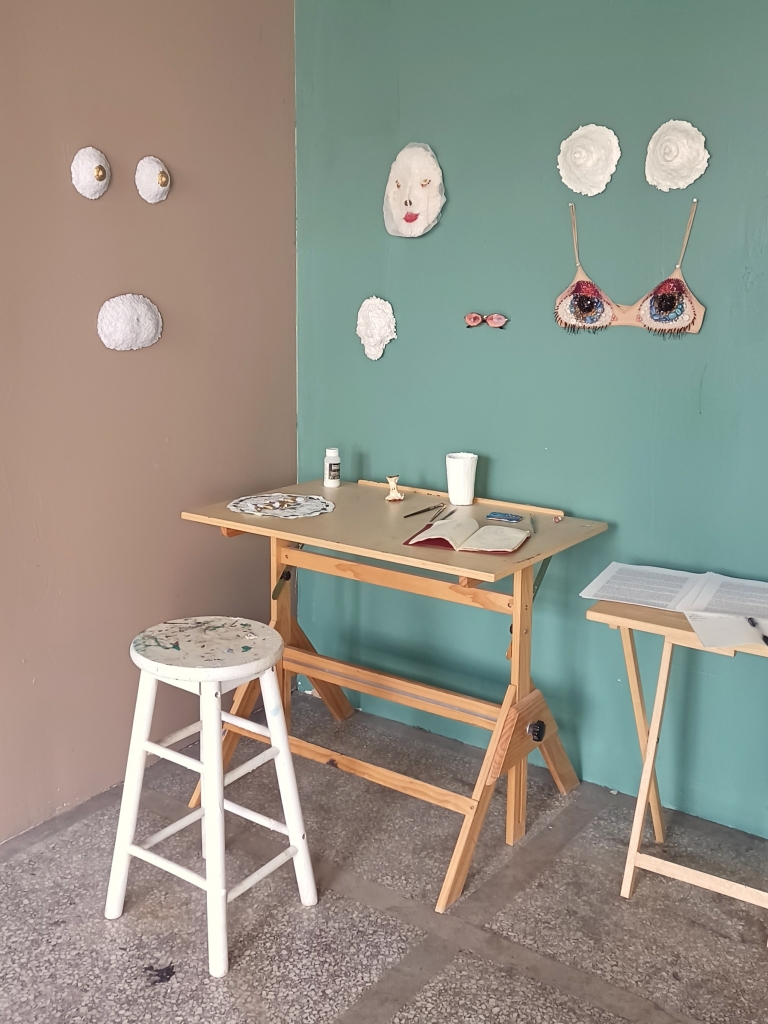
Attention grabbing works a bit further into the space are the bright acrylic skins hanging near the middle of the gallery that are made to look like human skins. They are both funny and grotesque, draped over coat hangers suspended on a closet bar, as if the dotted paint garments are the artist’s human self waiting to be put on. The skin, our largest organ, allows us to feel, to touch and be touched, and to a figurative painter, the skin is so important. The way human skin looks in different light, the way it can reveal our inner workings, our muscles and bones underneath, the ripple of cellulite, the pulse of blood, our fragility, our textures. To paint skin well is to have mastered one of the most difficult things there is to paint.
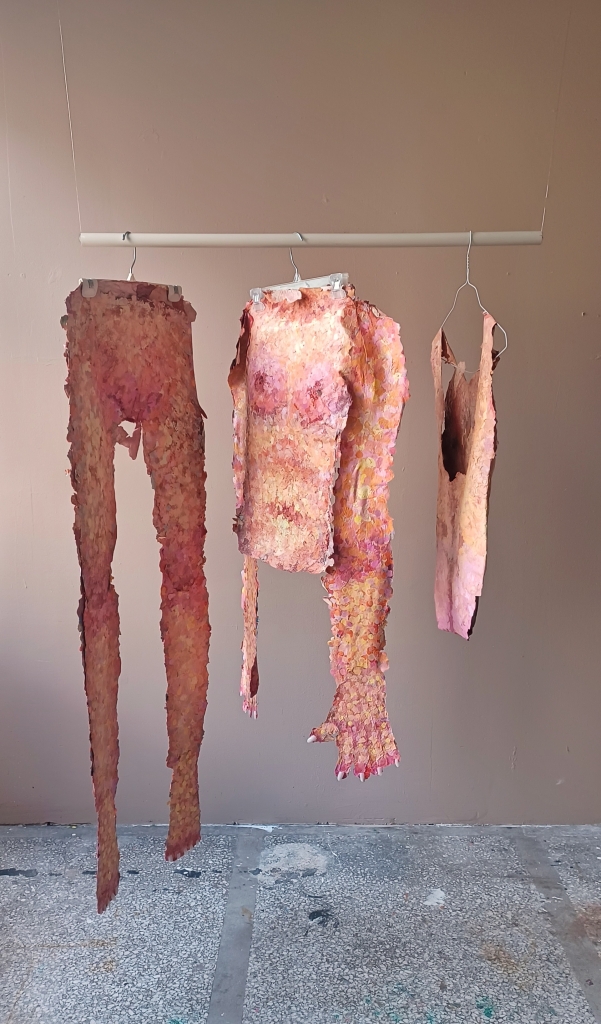
Pinned unstretched on the wall near the skins are oil paintings of Sokolovskaya’s lover posing with them. It is a bit meta, since the acrylic skins are rendered in a painterly, almost pointillist or pixelated way, and then we have two paintings from this year of the skins posed with real humans. In My Bed, shows lovers’ legs stick out from under the bed covers along with the feet of her acrylic skin. It makes me think of someone sitting with the memory of a person who is about to fade away, vanish into little dots of colour. These paintings show intimate scenes, that are a bit comical and also sad in a way. They remind me of how we sometimes cling to outworn relationships, to who we thought our lovers were, to the memory of them. On the other canvas, Your Arm, Sokolovskaya’s lover’s arm is embracing the skin of her body left behind, as if she shed it like a snake and he remains in bed with what is left of her. The human experience is inherently tied up with mortality, with wear and tear, with love and loss. Sokolovskaya touches upon this with quirky curiosity and a touch of existentialism. The unstretched canvases themselves speak to the transitory nature of the artist’s relationship between New York and Montreal. They were rolled and put in her luggage and brought on the train from city to city.
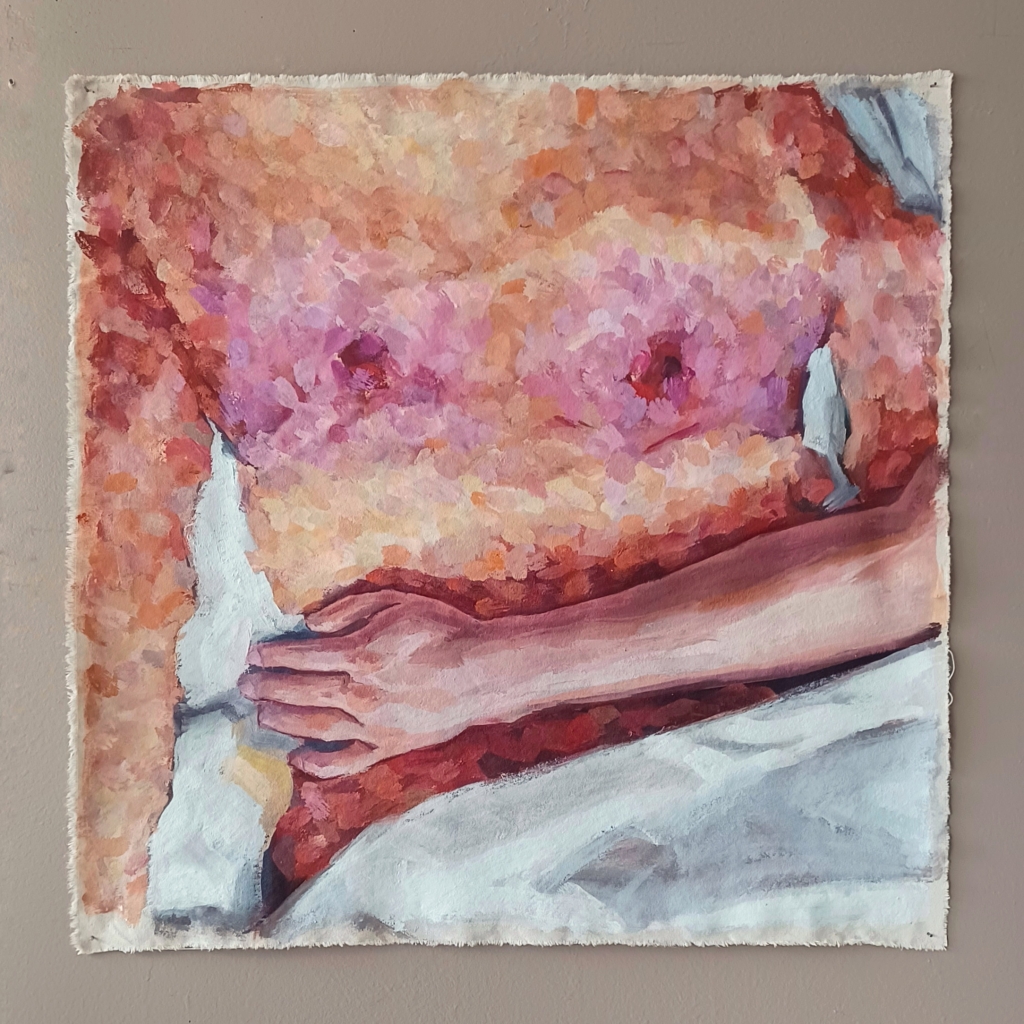
In painting, Sokolovskaya often makes portraits, painting models in class, friends, and most typically, herself. She is interested in moments that are unposed, unusual, funny, and even unflattering. Conventional beauty is not a primary interest to her in making work, and she even explores what many would call ugliness, and yet her work is often beautiful because of her skill with light, colour, and her ability to seemingly effortlessly render skin, bone, and body through a series of dynamic, rapid, yet keenly observed brushstrokes.
Perusing the show feels as if you are creeping in voyeuristically on a private space of the artist in an intimate moment. The ghost of Sokolovskaya—painted loosely on a clear curtain— showers nude in a corner, while on the bed a slice of New York margarita pizza waits for her. Blue-rimmed bowls from her childhood in Uzbekistan and round, hearty Uzbek bread are memories waiting to comfort her, while on the futon bed is a Tarot spread of three cards perhaps indicating a question about the future. The thick cards, the Tower, the Fool, and the Magician, set the tone for change and upheaval, with a touch of hope. The cigarettes which discretely fill the space, in corners, on the sheets, in a bowl, suggest the persistence of a habit, or anxiety. The butts glow with life, skillfully painted, they seem hot and flammable. Some are long with ashes, and some are even gold, as if they are fantasy cigarettes. Sunny side up eggs are scattered around on paper plates, and even loose on a shelf, making the place appear both strange and lived-in. Are these dreams of eggs? Who is this messy, hungry person?
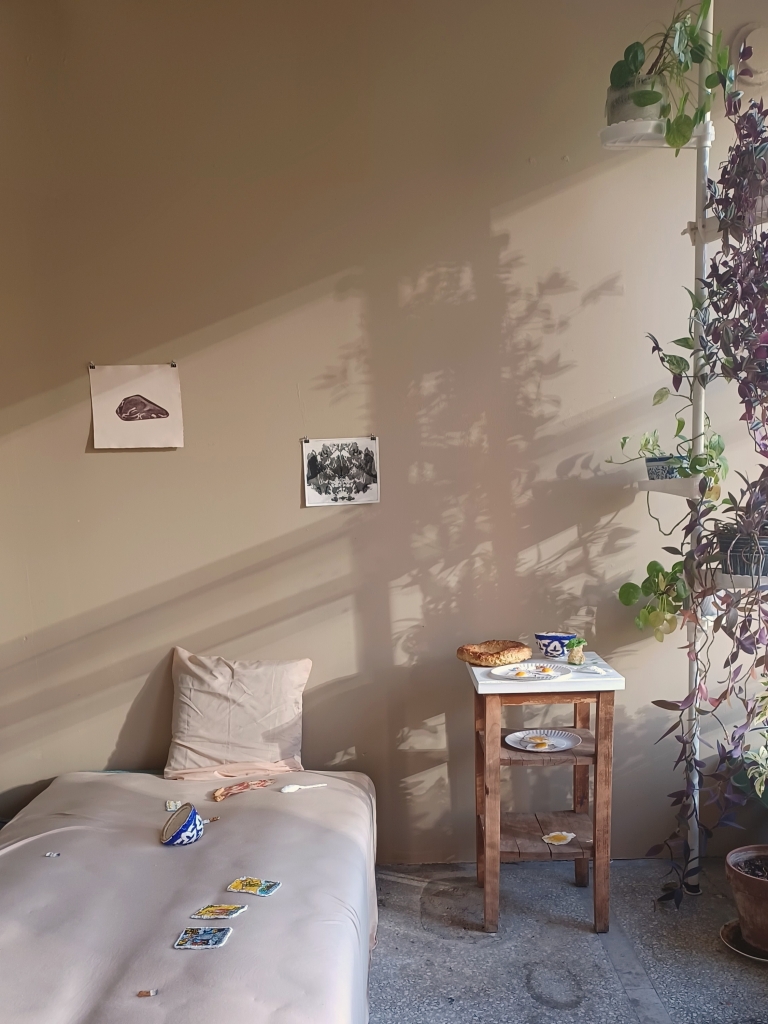
We find her painted loosely in the corner on the shower curtain, a nude brunette, soaping her pits. Acrylic skins of a one-piece bathing suit and bra and panties hang beside. Perhaps the artist is showering paint from her body, or returning from the pool, and will get dressed afterwards, have a cigarette, and think about her next painting while eating her slice of pizza or finishing her eggs. On the bed we find an acrylic skin of a sock that looks like it could have come out of a Phillip Guston painting. Papier mâché Opus and Metro cards make it especially clear the on-the-ground relationship to both cities Sokolovskaya has, and they are strikingly accurate, but also cartoon-like, somehow, in the way they are rough and thick, the opposite of what the sleek familiar cards are. The most erotic painting in the show, Red Body, is an oil painting tacked up by the shower, a pink torso of Sokolovskaya done from a steep perspective that calls to mind nudes one might send to a lover late at night, as seemingly huge fingers graze the bare surface of her pubic mound and her breasts fade off into darkness. The image is faceless.

There is a zest for life here, a hope for the future, and a nostalgia for the past, what could have been, what was and what wasn’t. The works call to mind the way that memory functions, they are wobbly, melting away in a moment. Memories are not as clear from year to year, and eventually they become memories of memories, cartoon-like. Sokolovskaya’s first solo show is a synthesis of everything that came before, and a promise for what is to come, when she returns to Montreal—as this exhibition foreshadowed—to live and work. As in Joseph Campbell’s Hero’s Journey, however, she doesn’t return empty-handed. She returns with new knowledge, new skills, new relationships, and the drive to create new works. She also returns with the aim to create community, which she has been doing for a few years now with her Artist Confluence project that she is bringing to Montreal.
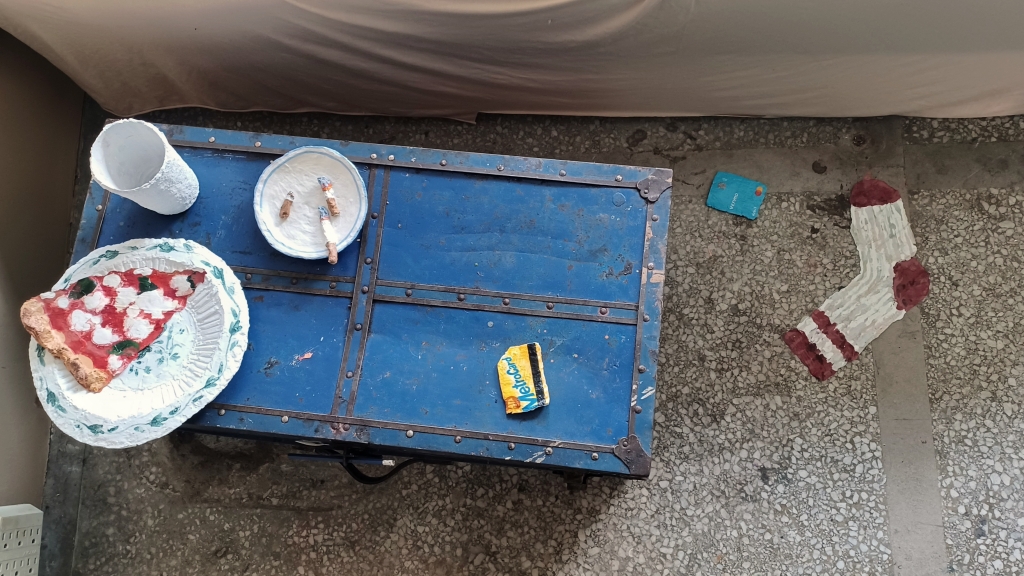
It is the Closest We Will Be is a strong first show from an artist keenly interested in personal reflection, materiality, and experimentation. Deeply considered and finely executed, the works in this show don’t take themselves too seriously. Sokolovskaya seems to have an innate understanding that life is best felt deeply and lived lightly. To do being human well is to be powerfully present while remaining skilled at all the release and letting go that necessitate the mortal experience. In this installation there is a fascination with the self that is the pursuit of many figurative painters, especially young ones—the questions “Who am I? Where have I come from? Where am I going? Why am I here? Can I make others understand me?” arise from all deep thinkers and feelers. But beyond the personal, there is also a fascination for what it means to be human, what it means to deeply inquire, to deeply seek to understand and interpret one’s own human journey, which, although unique, is an experience we all share.
]]>
Fait ou défait, c’est idem
Galerie Deux Poissons
July 12-August 25, 2018
What I found most striking about Fait ou défait, c’est idem, Galerie Deux Poisson’s fourth show, was how collaborative it was, how well the works of these four artists worked in a sort of humble synergy that was at once nameless and named. The show was curated by artist and writer Benjamin Klein, and the curation was strong in this group show; I find group exhibitions are exceedingly hard to pull off, as they too often seem forced, like a gaggle of people compelled to hang out awkwardly. Either they don’t seem to relate at all or they are gathered simply by common theme or medium, having nothing else to bind them together. In this exhibition, however, that was not the case. It had a real grassroots feeling, a sense of true collaboration and excitement. I am going to refrain from describing each work individually; the spirit of this exhibition is the sense of unity and togetherness that makes all the pieces work as a whole.
Fait ou défait, c’est idem, translated as “done or undone is the same”, alludes to the process of art-making. How does one know when a piece is completed? Is it ever truly done? An artist can stop working at any point and call it finished, no one can ever truly know when a piece is completed, including, oftentimes, the artist. It becomes a choice, an intuition, or it could come with being fed up or having a deadline. The word faire in French means both “to do” and “to make”, so, evocatively, the show’s title could also declare, “made or unmade, it’s the same.” One’s making and one’s doing carry the seed in the same word, as well as its opposite, as from the moment we are born—or made— we start dying.
The first thing one would encounter when entering the gallery is, ironically, a painting by Malcolm McCormick entitled, The End. It’s roughly but tenderly composed, with black “photo corners” and white script declaring “The End” in the middle. It is plaintive, mock sentimental and also cute. Smears of mustard-paint allow one to see the underpainting as if through a screen.
If one doesn’t strictly make the rounds, the visitor would likely then notice the impressive installations at the room’s centre. On the floor is a piano-shaped wood and cloth structure titled The Sparrow on the Hill Sees the Fool Going Around by Malcolm McCormick, a painter who also works with drawing and installations. Inside are works on paper by Mathieu Lacroix and Rachel Crummey, and ceramic hands by Michelle Furlong, along with found objects. There is a play on collaboration here, music is more frequently made in a group, multiple instruments and players create greater complexity than one individual is capable of.
Behind this piece, on a white block rests a piece by Lacroix, another legless piece—do we have a leg to stand on without our friends and collaborators?—is a three-legged chair propped up by stacks of papers and drawings, with a ceramic hand by Michelle Furlong pointing to a spot in the stacks. After this, certainly one could not help but be drawn to the immense in situ mixed media wall piece and installation by Rachel Crummey and Michelle Furlong towards the back of the gallery, titled Experience no. 2, after a piece by John Cage. Layered with bold and gestural marks in charcoal, graphite powder, acrylic paint and spray paint, the eye follows the energy of two artists and one can’t help but visualize their process, working together, erasing the work of the other, wondering if they worked in harmony or at times, adversarily. I think of how Robert Rauschenberg came to de Kooning to ask him if he could erase one of his drawings, which was allowed. Klein told me that he witnessed the process, allowing the artists to work uninterrupted, and saw how many times it could be completed, yet a new movement and shift began. It seemed a process fraught with dynamism and energy. The piece is so energetic that it cannot be contained to the wall.
A large piece of cheap-looking wall-to-wall carpet was contorted on the floor and subjected to the treatment of paint, recalling Furlong’s crumpled painted canvases. Most of the works in this show walk a thin line between ugliness and beauty, humility and humour. A leg made of black faux fur projects from the wall, reminding me of Dada creations. The piece sports rope of a gaudy purple shade, connecting the wall to the folds of carpet like an umbilical cord, its colour standing in stark contrast to the rest of the piece’s monochrome.
A painted disc of carpet stands alone like punctation on the floor, and large strips of black velcro and fringe with what appear to be large black pasties could suggest a crude face. The sort of feminine grunge aesthetic of Crummey and the slick, cool aesthetic of Furlong make an uneasy but pleasing contrast which gives the work a sort of personhood, even beastiness. I imagined it being made with John Cage playing in the background, the artist’s gestures and erasures moving to the sound like the surges of a symphony.
Scattered throughout the exhibition are Michele Furlong’s shiny, black-glazed ceramic hands pointing, squatting and hiding. They made me think of Thing in the Addam’s family, and their ubiquitousness felt as if they were the same hand, everywhere. They seemed at times to be the hand of the curator, invisibly and gentling guiding your attention.
Rachel Crummey is an award-winning Toronto-based abstract artist (and writer) working with painting, drawing and installation. Her work is layered, rich, and informed. She is an emerging artist who received her MFA from the University of Guelph in 2014. Her work is most successful in series, and this exhibition has a few of her works on paper, oil pastels on paper and acrylic on board or canvas. Her play of lines and layering is often very graceful. As in Experience no. 2, her installations in charcoal and graphite look like traces left by a ghost or the residue of a spirit or slug, but it could also be a kind of unusual wallpaper, worn with time and peeled away in strips. Her small works in this show are subtle in comparison to the collaborative installation, and quite accurately she describes her work as a “softly moving web.” One of her most engaging pieces here is a network or lung of actively tangled blue lines, made from oil pastel on paper. Much of her work is very tender and touching, and improvisation plays a strong role in her practise.
Malcolm McCormick is a primarily a painter (and drawer) but is also a multi-disciplinary artist. He’s from Vancouver and came to Montreal as an MFA candidate at Concordia. He’s spoken of being interested in colour, the formal aspects of making, collage-style work and things that are non-monumental and subtle. His work is sometimes wryly humorous and it has a sensitive yet painterly touch.
Besides The End, another funny piece sits on the floor saying: Take Me Home. Another work is an invisible house where all you can see are illuminated windows and a hastily painted, blue-steel background with brown ground and green grass, uneven letters imploring the viewer. Does the artist wish to go home, or the painting? Every painting for sale in fact says this wordlessly, and it was charming to have it so imploringly stated as it wasn’t even hung. His other oil painting, Banging Your Head Against a Warm Rock was textured with pebbles and almonds. Overall, McCormick’s work is deceptively simple, endearingly unostentatious, but skillfully handled and exploratory. McCormick said in an interview for his Kelowna Art Gallery duo exhibition in 2017: “ I like to make things that show an accumulation of decisions, and to leave traces of each decision so that the viewer can come into it and get a sense of how this thing developed over time”. The poetically titled, “Looking into His Ear” is a painting layered with transparent polkadot fabric, which leads one to visualize the layers and channels of the body and the delicacy of listening and looking.
Michelle Furlong is a Montreal-based multi-media artist, a recent graduate of Concordia’s Painting and Drawing program. Her work frequently consists of cutouts, textiles, texture, silhouettes, sharp contrasts, soft forms, stylized shapes and often, a cold, almost graphic, design. working primarily in paint, drawing and sculpture. Her work is largely concerned with the body, and hands are a major player. Her drawing sits on the floor in the corner, and is layered with outlines of hands, much as a child would use their own body as a starting point for making shapes and forms, and paint with their fingers. The effect of the ghost-like hands layered in blacks and whites and layers of charcoal, using negative space, and tucked away on the floor is at once haunting, playful, and evocative. There is a sense of ephemerality and whimsy, an awareness of temporality, of the limitations to the corporeal form in Furlong’s work. The hands play throughout the gallery, dark and shiny, slick, but not sinister.
Mathieu Lacroix is a Montreal native and multidisciplinary artist who received his BFA at UQAM. His grid of drawings here are reminiscent of architectural drawings, but also de Chirico. Some are on vellum, some on brown packing paper. There are elements of collage, and they are all cleverly composed, contemporarily-aware works that aren’t precious at all, which is why, I suspect, he titles all of these works NON ART. They fit perfectly with the drawing theme of the exhibition and the sense that creativity will continue and art will be made regardless of the means at one’s disposal. These are unpretentious drawings, and, despite being a rather conceptual show, Fait ou défait, c’est idem is also quite unpretentious and certainly process-oriented. Lacroix’s drawings contain a sense of resilience in their delicacy. His work uses reclaimed and recycled materials such as cardboard, ordinary, cheap substances. Art can and will continue without expensive materials and resources that often make it the domain of the privileged. Lacroix’s playful sculpture, NON ART: Chair, calls to mind the absurdity of Dada, a three-legged chair. Is it a comment on academia? The third leg is made of theory, of drawings, of studies. All of his works in this show are labeled emphatically NON ART, and then given a secondary title, in this case, NON ART: Chair. As an artist he to seek to connect to the ordinary and mundane through his subject and media, then thwart our expectations. These drawings engage with formal abstraction and imaginary space. We see a square building with grass growing out of its centre, long black hair pouring down like a waterfall; we see what may be a railroad station with water emerging through it being transformed in shape by its passage through the building, the rails of which pour with light, a power station, an A frame building overruled by a flow chart, a collision of realities and geometries, an unusual combination of formal fascination and dreamy imagination. They could be diagrams made on acid or instructions for or by aliens for human society.
The works here as a group, and even individually, don’t say “I, I” they say “us, we”. There is a particularly Montrealaise spirit here, a sort of “struggling artist”, communal sensibility of resourcefulness, resilience and joie de vivre. There is strong sense of line, of hesitant but necessary declaration and bold erasure. The marks made by the individual on the world, the lines that tie us together. The connections. The overlap, the influence. The give and take. This exciting and ground-breaking exhibition is a sign of innovative work both in artistic production, support for emerging artists and dynamic curation taking place at Galerie Deux Poissons and bodes well for future developments. Galerie Deux Poissons is a blessing for the artistic community of Montreal for its role in maintaining the importance of the Belgo Building as a Montreal landmark which has recently lost some important galleries.
]]>
Amélie Fortin: 125 Hours
Galerie B-312
September 9 – October 8, 2016
Galerie B-312 starts the new season hosting two interesting exhibitions, The Cellule dedicated to Mathieu Latulippe and One Hundred Twenty Five Hours to Amélie Laurence Fortin. They are both multidisciplinary artists discussing in different ways issues of Time and Space in the contemporary world.
Mathieu Latulippe presents several works using different media to explore the links between the world of medicine and the environment, especially the concept of health care in rapport to the architecture, landscape and nature.
Mathieu choose the Sanatorium, a medical facility for tuberculosis located in the mountains, as metaphor to investigate important themes such as Rationality vs Irrationality and Nature vs Science.
Photo archives, paintings and medical tools displayed at the exhibition refer to it and to the myth of an invincible science. But what are some of the limitations of science? How far will technology go? Could humanity live completely self-sustained in a technological world?
In a transparent technological cell in the middle of the room, a sculpture of a child looks at us through swimming goggles. We are not able to see his eyes. We are not sure he’s breathing air.
Despite his aseptic and clinical environment, a painting of a mountain stands out, as nostalgia for something he’s never experienced. In the cell, normal laws of reality no longer fully apply and laws of nature are supposedly suspended.
As in the science fiction art film Stalker (A.Tarkovsky, 1979) in which the Stalker works in some unclear area in an indefinite future through the “Zone”, Mathieu Latulippe’s work demands us rethink the relationship between desires of invincibility and reality, the vagaries of human intentions and the need for mystery. He invites us to rethink our thoughts about technology and its dangerous consequences.
As Stalker said in the film: “[…] the zone is exactly how we created it ourselves, like the state of our spirits… but what is happening, that does not depend on the zone, that depends on us.”
Amélie Laurence Fortin presents a minimal black sculpture hanging from the ceiling. From a tiny hole a non-stop trickle of small glass marbles flows into a geometric cavity on the floor. Like a large hourglass, the mysterious sculpture becomes a device used to measure the passage of time. In this case, 125 hours, as the title suggests. In fact the sand’s quantity is regulated to the exhibition’s period. Once the 125th day is reached, the sand will cover the whole cavity.
It’s a mobile sculpture, changeable with the time. The viewer is able to see the entire process and get lost in idea of time: thoughts of the past, days, years, or the future are all conceptual ideas, paradigms, which exist only in our mind. In Amélie’s work, Time, an abstract concept, becomes a real physical entity.
The dramatic light, the minimal shapes, the black and white colors and the silence remind us of a solemn event commonly perceived by all cultures and viewers.
Amélie’s work explores the time to be experienced with the mind. Analyzing time, the viewer will also need to be aware of their perceptions as well. What are the eyes that sense the light of day and darkness of night? Without an understanding of consciousness that is perceiving time, how will we know if our understanding is distorted or not? How do we fit this variable of changing perspective of the viewer as we seek to understand truth?
Another incredible movie comes to mind.
As in 2001: A Space Odyssey film (Kubrick, 1968) the iconic monolith has been subject to countless interpretations, Amélie’s work suggest multiple thoughts.
It is up to us to find our own.
Eleonora Milner
]]>Galerie Trois Points
11 June-20 August 2016
Marie-Christine Dubé and John Boyle-Singfield, curators of the exhibition Harder, Better, Faster at Galerie Trois Points, set out to create a myth which “reinforces the empowerment of womenâ€ s identities,†an ambitious aim that it achieved very well. As I made my way through the exhibition I wondered if this show did what it set out to do, or whether it simply, but fascinatingly, reflected the status quo. The first impression on entering the gallery was one of paradox; the sleek polish contrasting with the gritty and the rough. We are inducted into a realm of “projected images†which explore the representation of the self and the other through a primarily feminist lens, delving into the complex issues of gender and cultural identity.
s identities,†an ambitious aim that it achieved very well. As I made my way through the exhibition I wondered if this show did what it set out to do, or whether it simply, but fascinatingly, reflected the status quo. The first impression on entering the gallery was one of paradox; the sleek polish contrasting with the gritty and the rough. We are inducted into a realm of “projected images†which explore the representation of the self and the other through a primarily feminist lens, delving into the complex issues of gender and cultural identity.
The first encounter is with a video installation of young Montreal new media artist, Mégane Voghell, a piece called How to Remove a Lady from its Flesh. The video is projected on a board surrounded by a yellow rectangle which appears to be spray painted on the wall. Jutting out from the video presentation is a simple table decorated with various photos of other simple tables of its kind, some with happy and sad faces made up of crustaceans. The video is a non-linear collage of influences and impressions, itself seeming to question the oppressive implications of female self-representation in our society; images which range from a girl plastering on concealer, her image viewed only through a tablet computer to another woman draining a huge blister, a picture-within-a-picture surrounded by blurred faces and forms. Virtual reality collides with the camouflaged dimensions that we create for ourselves and are inundated with continuously. A womanâ€ s world is a flood of images, expectations and ideals we are supposed to live up to. A nude pregnant woman sits in a bathtub outside while a toddler runs around, and she separates from a drawn image of herself, which seems to be a Photoshop filter. Digitally-created red hair forms a towering figure with a pornstarâ€
s world is a flood of images, expectations and ideals we are supposed to live up to. A nude pregnant woman sits in a bathtub outside while a toddler runs around, and she separates from a drawn image of herself, which seems to be a Photoshop filter. Digitally-created red hair forms a towering figure with a pornstarâ€ s body. Similar to a computer game visitors can select from faces without hair and hair without faces, which can be selected and chosen at will to represent the self. Meanwhile words like “short memories and unsharp masks†flash on the screen. A yellow square follows a raw young womanâ€
s body. Similar to a computer game visitors can select from faces without hair and hair without faces, which can be selected and chosen at will to represent the self. Meanwhile words like “short memories and unsharp masks†flash on the screen. A yellow square follows a raw young womanâ€ s practised smiles which belie the anxiety in her eyes: “Shy and daring at the same time.†This fragmented, repellant yet fascinating piece successfully subverts narrative expectations and usual space, bringing you into an alternate reality. It is quite a mature presentation especially for one of Voghellâ€
s practised smiles which belie the anxiety in her eyes: “Shy and daring at the same time.†This fragmented, repellant yet fascinating piece successfully subverts narrative expectations and usual space, bringing you into an alternate reality. It is quite a mature presentation especially for one of Voghellâ€ s age, and it will be very interesting to see what she produces in the future.
s age, and it will be very interesting to see what she produces in the future.
Next are Stéphanie De Couto Costaâ€ s three lovely stone lithographs, each showing a woman in a state of transformation, suspended in a void of white. De Couto Costa is a second generation immigrant artist who uses feelings of cultural dissonance to retell and thwart fairy tales in works on paper inspired by feminist writing and poetry. She says her series The Bitch and the Blond is “inspired by vanity portraits and the works of women storytellers.†Notions of transformation and duality wrestle with sensually-charged portraits, women caught in a morphological state, half-this and half-that. Road Kill shows a woman crawling seductively on all fours, howling from her wolf-head, her body bearing a shroud like a skin. Mimesis shows a raven-woman, head on backwards, back facing us. Which side is front? From which side of ourselves do we express and perceive? A long veil or train of feather-cloth trails down her front. Clothing, to De Couto Costa, seems to act not only as a decorative, protective layer but a psychologically protective one as well and a signifier of identity in transformation. Motherâ€
s three lovely stone lithographs, each showing a woman in a state of transformation, suspended in a void of white. De Couto Costa is a second generation immigrant artist who uses feelings of cultural dissonance to retell and thwart fairy tales in works on paper inspired by feminist writing and poetry. She says her series The Bitch and the Blond is “inspired by vanity portraits and the works of women storytellers.†Notions of transformation and duality wrestle with sensually-charged portraits, women caught in a morphological state, half-this and half-that. Road Kill shows a woman crawling seductively on all fours, howling from her wolf-head, her body bearing a shroud like a skin. Mimesis shows a raven-woman, head on backwards, back facing us. Which side is front? From which side of ourselves do we express and perceive? A long veil or train of feather-cloth trails down her front. Clothing, to De Couto Costa, seems to act not only as a decorative, protective layer but a psychologically protective one as well and a signifier of identity in transformation. Motherâ€ s Ghosts is not an anthropomorphic transformation, rather it seems as if a tribal costume is in a state of becoming, or is perhaps overtaking the woman. Roots creep in, the figure is headless as she disintegrate into petals or into the earth, a state of disappearance. Feathers, braids and textures cluster in chaotic but elegant profusion and make me think of the disconnect many of us feel from our heritage, and particularly of the pain that must be felt by indigenous peoples. De Couto Costa works in multiples in her process-oriented printmaking practise, and seems to meditate upon ideas of replication—of story, identity and of people themselves, continuously birthed and passing on knowledge and problems.
s Ghosts is not an anthropomorphic transformation, rather it seems as if a tribal costume is in a state of becoming, or is perhaps overtaking the woman. Roots creep in, the figure is headless as she disintegrate into petals or into the earth, a state of disappearance. Feathers, braids and textures cluster in chaotic but elegant profusion and make me think of the disconnect many of us feel from our heritage, and particularly of the pain that must be felt by indigenous peoples. De Couto Costa works in multiples in her process-oriented printmaking practise, and seems to meditate upon ideas of replication—of story, identity and of people themselves, continuously birthed and passing on knowledge and problems.
Olga Chagaoutdinova, native to Russia, but educated in Montreal at Concordia, is a talented conceptual photographer who captures lives in countries caught in the awkward in-between state between communism and capitalism, Russia and Cuba specifically. This series of photographs of female prison inmates are intimate portraits taken after long discussions with each inmate. At first glance, it isnâ€ t apparent that they are prisoners, as they are allowed to wear normal clothes, and their prison badges arenâ€
t apparent that they are prisoners, as they are allowed to wear normal clothes, and their prison badges arenâ€ t glaringly obvious; they simply look worn out by life, possibly former drug users. Knowing that the photographs were taken after what must have been an emotional interview adds poignancy and humanity to the grid-like portraits, which in their intimacy, also reveal the walls and defenses in their visage.
t glaringly obvious; they simply look worn out by life, possibly former drug users. Knowing that the photographs were taken after what must have been an emotional interview adds poignancy and humanity to the grid-like portraits, which in their intimacy, also reveal the walls and defenses in their visage.
Montreal artist Dominique Siroisâ€ installation, Mimesis Trinyty, a conceptual space set in a fictional world of finance, is a video on a screen of a digital woman with a certain likeness to Uma Thurman from Pulp Fiction, reciting a computer generated text which combines the writings of André Orléan and Flaubertâ€
installation, Mimesis Trinyty, a conceptual space set in a fictional world of finance, is a video on a screen of a digital woman with a certain likeness to Uma Thurman from Pulp Fiction, reciting a computer generated text which combines the writings of André Orléan and Flaubertâ€ s Madame Bovary. Round, dark pillows scatter the floor and there is a leaking of boundaries of sound and matter around the gallery as oddly-shaped sculptures are scattered sparingly from room to room and the bland computer voice echoes soft words in French. Nub-shaped polystyrene sculptures with the appearance of concrete are piled on top of each other, forming lines of replication with a few tiny indeterminate objects resting on them. A small workout weight rests on an amorphous sculpture. The wall behind the video is papered with black and white simplified womenâ€
s Madame Bovary. Round, dark pillows scatter the floor and there is a leaking of boundaries of sound and matter around the gallery as oddly-shaped sculptures are scattered sparingly from room to room and the bland computer voice echoes soft words in French. Nub-shaped polystyrene sculptures with the appearance of concrete are piled on top of each other, forming lines of replication with a few tiny indeterminate objects resting on them. A small workout weight rests on an amorphous sculpture. The wall behind the video is papered with black and white simplified womenâ€ s faces, another nod to replication and feminine identity. Sirois frequently works with ideas of finance, and this installation is no exception. This financial world opens with a desk, the seat of power of a company perhaps, and the text speaks of muscular training. Merged with Madame Bovary, one cannot help but think of the role of women as property throughout the ages, their lives of increasing free agency and their current role in the financial world. We gain more power and “muscleâ€, but what have we got ourselves into? A complex world where we must flex our power even more dramatically to keep up. Harder, better and faster. The interpretation is left open and curious, which is part of what makes the piece a success.  The virtual reality/alternate reality presented here is a reflection of our own world, another quantum possibility. There is a sense of being trapped, as Bovary was, by her finances and need to spend to fill a void.
s faces, another nod to replication and feminine identity. Sirois frequently works with ideas of finance, and this installation is no exception. This financial world opens with a desk, the seat of power of a company perhaps, and the text speaks of muscular training. Merged with Madame Bovary, one cannot help but think of the role of women as property throughout the ages, their lives of increasing free agency and their current role in the financial world. We gain more power and “muscleâ€, but what have we got ourselves into? A complex world where we must flex our power even more dramatically to keep up. Harder, better and faster. The interpretation is left open and curious, which is part of what makes the piece a success.  The virtual reality/alternate reality presented here is a reflection of our own world, another quantum possibility. There is a sense of being trapped, as Bovary was, by her finances and need to spend to fill a void.
Olivia McGilchrist is a photographer and video artist of Franco-Jamaican origin, whose work has largely dealt with post-colonial white identity in a predominantly black culture, and her sense of marginalization. She often takes this challenging subject for her lovely portraits, and her street nickname “Whitey†has formed what has become a recurrent character in her work, the artist appearing in a white mask. McGilchrist considers whiteness to be a mental construct as much as a physical one. This immersive video installation, From Many Sides, is a departure from that theme, a side step, and it seems the artist has dealt with her issues of being an outsider for now, here merging myth very successfully in a beautiful piece. We encounter the River Mumma, or river mother/mermaid figure, a black woman swimming in the ocean, wearing a white mask—but she isnâ€ t Whitey. The white-masked black figure also occurs in the Jamaican folk dance, Jankunu, so McGilchrist is exploring not only her personal identity but a cultural and mythical one as well. In this installation, lucid colours and multiple tracks blend from one to the other, with a soft, dreamy soundtrack of birds, whispers and lapping waves. We feel connection rather than dislocation. We see girls walking down an overgrown road, a family gathering at a grotto, a girl in white shorts gathering water with crockery in a river. We feel the thick haze of colour and lush emotional states. Crashing waves, pure beauty, a magical invocation on a primordial, sleepy island. It is an overwhelmingly lovely mosaic of overlaying ripples, forms and reflections. The pervasive sense of place gives you a feeling of the power of nature upon the culture. McGilchrist deals with collective and intimate memory and as well as identity in a postcolonial landscape very effectively here.
t Whitey. The white-masked black figure also occurs in the Jamaican folk dance, Jankunu, so McGilchrist is exploring not only her personal identity but a cultural and mythical one as well. In this installation, lucid colours and multiple tracks blend from one to the other, with a soft, dreamy soundtrack of birds, whispers and lapping waves. We feel connection rather than dislocation. We see girls walking down an overgrown road, a family gathering at a grotto, a girl in white shorts gathering water with crockery in a river. We feel the thick haze of colour and lush emotional states. Crashing waves, pure beauty, a magical invocation on a primordial, sleepy island. It is an overwhelmingly lovely mosaic of overlaying ripples, forms and reflections. The pervasive sense of place gives you a feeling of the power of nature upon the culture. McGilchrist deals with collective and intimate memory and as well as identity in a postcolonial landscape very effectively here.
The finely curated works in Harder, Better, Faster serve to question and illuminate the often dark and oppressive spheres of influence, self-censorship and self-representation—mirrored in those processes by the other or the powers that be— as well as the passing on of ideas, of mimesis, of cultural connection and disconnection.
]]>The Whole World Has Gone Joyously Mad
June 8-July 16, 2016
www.joyceyahoudagallery.com
I first encountered Farajâ€ s work this year at Papier in Joyce Yahouda Galleryâ€
s work this year at Papier in Joyce Yahouda Galleryâ€ s booth, tucked away around a corner, presumably because of their explicit erotic content. The lovely, bleeding watercolour images of recumbent women exposing themselves in a sexual and unabashed attitude were quite striking, and I found myself drawn to them over and over throughout the event. While this solo exhibition, The Whole World Has Gone Joyously Mad, at Joyce Yahouda Gallery also deals with female nudity, the take is decidedly more political. Ranging from whimsical yet powerful portraits of Muslim feminists to representations of the Montreal tuition hike activists, this installation by Faraj honours the courage of those women who use their nudity to protest. According to Faraj, they inevitably also display their vulnerability by such bold acts which use their own bodies to make a statement. To me, that is a further testament of their courage.
s booth, tucked away around a corner, presumably because of their explicit erotic content. The lovely, bleeding watercolour images of recumbent women exposing themselves in a sexual and unabashed attitude were quite striking, and I found myself drawn to them over and over throughout the event. While this solo exhibition, The Whole World Has Gone Joyously Mad, at Joyce Yahouda Gallery also deals with female nudity, the take is decidedly more political. Ranging from whimsical yet powerful portraits of Muslim feminists to representations of the Montreal tuition hike activists, this installation by Faraj honours the courage of those women who use their nudity to protest. According to Faraj, they inevitably also display their vulnerability by such bold acts which use their own bodies to make a statement. To me, that is a further testament of their courage.
One enters this installation by passing through two sentinels—phallic tree trunks, tipped with a cadmium red that almost glows and drips down the shaft. To exit the installation, one must also pass these guards, each of which bears the title Lingam. Lingams are egg-shaped, or round-tipped, pillar-shaped representations of the penis, usually in stone, which are honoured in India as symbols of the great god Shiva, the destroyer. They make an intriguing counterpoint to the feminist celebration on the wall, providing balance and seemingly, protection in the way you must walk between them to access the watercolours. They are the sacred masculine, perhaps representing the men who stand by our side and understand that the true nature of feminism is equality, not female supremacy. In India, Lingams are normally bathed in milk to be honoured, but these are tipped with red like blood, which could represent intensity of feeling, a throbbing erection, or the bleeding, vulnerable and damaged masculine principle.  I believe the ambiguity added a successful layer of mystery to this installation.
The watercolours span the largest wall of the gallery in a crowded grid which binds the portraits together in sisterhood. Faraj works in her familiar bleeding, stained style, but these are a little more hard-edged. These girls have some boundaries. They know what they want, and they want it now. Their mouths are open, their breasts bared, and often one or two arms are raised in vocalization, but their words are written on their chests.
These works are a loving tribute to those women who use their bodies to speak their minds. Farajâ€ s past work has been more distinctly sexual, a diversity of bodies merged in embrace or joyful abandon, their blurred boundaries and splayed limbs reflecting a wonderful freedom, while these works are a bit more resolved, and not sexualized. They are nudity as frankness, as honesty, and as protest.
s past work has been more distinctly sexual, a diversity of bodies merged in embrace or joyful abandon, their blurred boundaries and splayed limbs reflecting a wonderful freedom, while these works are a bit more resolved, and not sexualized. They are nudity as frankness, as honesty, and as protest.
Among the many striking and successful watercolours, a few stood out as my favourites. In Free the Nipple circles represent breasts with a red dot in the center, looking like targets drawn all over her brown skin.  In another portrait, a smoking and leather-cuffed brunette has words in Arabic written on her body, as well as the name “Aminaâ€, which is indubitably Amina Wadud, feminist cleric and professor of Islamic studies.
Considering Farajâ€ s watercolour stain paintings, one cannot help but think of Helen Frankenthaulerâ€
s watercolour stain paintings, one cannot help but think of Helen Frankenthaulerâ€ s abstract stain painting of the 50s. Faraj takes such techniques to a new level in her splendid watercolours, which go beyond political statement into a celebratory expression of joie de vivre. These women love life and will fight for the freedom to live as they want.
s abstract stain painting of the 50s. Faraj takes such techniques to a new level in her splendid watercolours, which go beyond political statement into a celebratory expression of joie de vivre. These women love life and will fight for the freedom to live as they want.
Joyce Yahouda Gallery | space 516
Paul Wong
Multiverse
September 10 – October 10, 2015
www.joyceyahoudagallery.com
A wall of flickering images depicts the many details of multimedia artist Paul Wongâ€ s daily life. Each image is visible for no more than half a second. The viewer is struck by the overwhelming quantity of content, and by the obsessive collecting that allowed its creation. Some of the GIFs include: geometric abstractions, a blooming rose, an iPhone message asking for confirmation to delete a photo, and a naked backside seen under a Pop Art filter. The personal mixes with the public, the figurative with the abstract, and the amateur with the professional. The images burn with the intensity of the everyday.
s daily life. Each image is visible for no more than half a second. The viewer is struck by the overwhelming quantity of content, and by the obsessive collecting that allowed its creation. Some of the GIFs include: geometric abstractions, a blooming rose, an iPhone message asking for confirmation to delete a photo, and a naked backside seen under a Pop Art filter. The personal mixes with the public, the figurative with the abstract, and the amateur with the professional. The images burn with the intensity of the everyday.
Capturing and exploring identity through digital imagery has always been an integral part of Wongâ€ s practice. As one of Canadaâ€
s practice. As one of Canadaâ€ s most respected, and prolific, artists he investigates what it is to be oneself in a society where itâ€
s most respected, and prolific, artists he investigates what it is to be oneself in a society where itâ€ s easy to be engulfed by overwhelming external influences and perspectives. Throughout his 40-year career, Wong has seen different technologies come and go. For many years, he carried two heavy cameras everywhere he went – one for video, and one for still photographs. Nowadays, his kit is much lighter. At a talk to open his exhibit Multi-Verse at Le Mois de la Photo à Montréal (MPM), he explained how smart phones have revolutionized his practice, saying, “Since I got the iPhone 6, itâ€
s easy to be engulfed by overwhelming external influences and perspectives. Throughout his 40-year career, Wong has seen different technologies come and go. For many years, he carried two heavy cameras everywhere he went – one for video, and one for still photographs. Nowadays, his kit is much lighter. At a talk to open his exhibit Multi-Verse at Le Mois de la Photo à Montréal (MPM), he explained how smart phones have revolutionized his practice, saying, “Since I got the iPhone 6, itâ€ s all I carry.â€
s all I carry.â€
This new media aspect of Wongâ€ s works allows it to speak to what MPM curator, Joan Fontcuberta, identifies as the establishment of a “new visual orderâ€. As one of the biennialâ€
s works allows it to speak to what MPM curator, Joan Fontcuberta, identifies as the establishment of a “new visual orderâ€. As one of the biennialâ€ s key conceptual frameworks, this idea incorporates the notion that societyâ€
s key conceptual frameworks, this idea incorporates the notion that societyâ€ s relationship with the image is fundamentally changing. Nowadays, images are: largely digital, readily available, and easily transmissible. Their now ubiquitous nature means individuals communicate via images on a day-to-day basis. Wong presents four pieces as part of the exhibit. Each work offers us a glimpse into the artistâ€
s relationship with the image is fundamentally changing. Nowadays, images are: largely digital, readily available, and easily transmissible. Their now ubiquitous nature means individuals communicate via images on a day-to-day basis. Wong presents four pieces as part of the exhibit. Each work offers us a glimpse into the artistâ€ s world, and most are an expression of his identity as seen through his social media. One piece is an outdoor video installation, and the remaining three are presented at Galerie Joyce Yahouda.
s world, and most are an expression of his identity as seen through his social media. One piece is an outdoor video installation, and the remaining three are presented at Galerie Joyce Yahouda.
In #LLL, Looking, Listening, Looping (2014), Wong covers a wall of the gallery with 40 tablets – each screen plays GIF animations on a continuous loop. Like much of his recent work, it was created and edited entirely on a smart phone. Each of the GIFs and videos were initially shared with his social media community through free apps like Vine, Snapchat, Instagram, and GIF Boom. He said that at the time he didnâ€ t give much thought as to what he may do with the images, and certainly didnâ€
t give much thought as to what he may do with the images, and certainly didnâ€ t plan to present them in a gallery one day. Their sole context was to be shared with his community of followers, online. The GIF and video content is varied, and ranges from selfies to more abstract imagery. In total, Wong presents 75 minutes of work, the equivalent of a feature length film; he said he considers each GIF as a scene from his life.
t plan to present them in a gallery one day. Their sole context was to be shared with his community of followers, online. The GIF and video content is varied, and ranges from selfies to more abstract imagery. In total, Wong presents 75 minutes of work, the equivalent of a feature length film; he said he considers each GIF as a scene from his life.
Standing in front of the installation, itâ€ s difficult to focus on any one tablet. However, to see each image within a GIF, it needs to be watched through at least a few repetitions. There is a sensation of distracted attentiveness that feels similar to being overwhelmed by online images, or scrolling through a Facebook feed. The feeling of being inundated by multiple photos, by the sheer quantity of content, is an integral part of Wongâ€
s difficult to focus on any one tablet. However, to see each image within a GIF, it needs to be watched through at least a few repetitions. There is a sensation of distracted attentiveness that feels similar to being overwhelmed by online images, or scrolling through a Facebook feed. The feeling of being inundated by multiple photos, by the sheer quantity of content, is an integral part of Wongâ€ s work. It raises the question: what is the point of all these images if itâ€
s work. It raises the question: what is the point of all these images if itâ€ s not possible to interact meaningfully with them?
s not possible to interact meaningfully with them?
Wongâ€ s outdoor video installation, Year of GIF (2013), was created from the content he generated during his first year of GIF-making. Originally constructed as a site-specific piece for the Surrey Urban Screen, it was adapted for projection onto the brick wall outside Montrealâ€
s outdoor video installation, Year of GIF (2013), was created from the content he generated during his first year of GIF-making. Originally constructed as a site-specific piece for the Surrey Urban Screen, it was adapted for projection onto the brick wall outside Montrealâ€ s Saint Laurent metro station. The work is a five-minute loop of 350 GIFs, all made on a smart phone. The content ranges from selfies, photographs featuring technology, individual portrait studies, art references, artworks, travel images, and architecture.
s Saint Laurent metro station. The work is a five-minute loop of 350 GIFs, all made on a smart phone. The content ranges from selfies, photographs featuring technology, individual portrait studies, art references, artworks, travel images, and architecture.
At his exhibit launch, Wong described how there is an interesting, yet tragic, link between his fascination with GIFs and his family life. Wongâ€ s mother, who currently lives with him, suffers from dementia. In describing the situation, he said she lives in a “magical, abstract world†of non-linear time. Adding that her memory can play in constant loops, replaying certain events, while completely losing others. The poignant link between the nature of GIFs and his motherâ€
s mother, who currently lives with him, suffers from dementia. In describing the situation, he said she lives in a “magical, abstract world†of non-linear time. Adding that her memory can play in constant loops, replaying certain events, while completely losing others. The poignant link between the nature of GIFs and his motherâ€ s memory is not lost on the artist himself.
s memory is not lost on the artist himself.
Wongâ€ s third work, Solstice (2014), is a 24-minute video, which captures an infamous Vancouver street at intervals over a 24-hour period. Made using the pixel motion filter tool in After Effects, it evokes surveillance imagery, and shows the comings and goings of an area known as “Crack Alley†– a popular place for drug consumption and trafficking. The pixel motion filter makes it seem as though figures are continuously appearing out of, and then disappearing into, thin air. They materialize as if conjured by some external force.
s third work, Solstice (2014), is a 24-minute video, which captures an infamous Vancouver street at intervals over a 24-hour period. Made using the pixel motion filter tool in After Effects, it evokes surveillance imagery, and shows the comings and goings of an area known as “Crack Alley†– a popular place for drug consumption and trafficking. The pixel motion filter makes it seem as though figures are continuously appearing out of, and then disappearing into, thin air. They materialize as if conjured by some external force.
Finally, Wong also presents Flash Memory (2010-2015), a four-channel video showing the iPhone photos he took over a four-year time period. Each channel is divided by year: 2008, 2009, 2010, and 2011. The channels scroll through each image at a rapid pace like when uploading photos from a cell phone onto a laptop. Wong said he came across the idea by accident when he was watching an upload onto his own computer. He added that he finds the way we look at images now, the way we scroll through them rather than closely examining each file, is very different from in the past. All images – good, bad, different, useful and not useful – are merged together chronologically, and awarded equal value in terms of the space they occupy in our mental memories, and in our digital memory systems. This complete blurring of amateur, professional, personal and public, is something Wong wants to convey with the work. The excessive accumulation of images is also a key idea explored by other artists involved in the biennial.
Wong is based in Vancouver, and works as a practicing artist, and curator. He is also the co-founder of several artist run organizations, and the director of On Main Gallery, which has been operating since 1985. His work is included in public exhibits at the National Gallery of Canada, the Museum of Modern Art (MOMA), and the Canada Council Art Bank. His current exhibit, Multi-Verse, will be on display until October 10, 2015, at Galerie Joyce Yahouda.
]]>Visiting Andrée-Anne Dupuis-Bourretâ€ s recent exhibit at Circa Art Actuel was like taking a step into the artistâ€
s recent exhibit at Circa Art Actuel was like taking a step into the artistâ€ s inner landscape. An immersive, sensory experience of protruding shapes and suspended reality, the environment altered regular visual and spatial perceptions.
s inner landscape. An immersive, sensory experience of protruding shapes and suspended reality, the environment altered regular visual and spatial perceptions.
Moving around the installation was similar to walking through a forest, or entering new, unaccustomed surroundings for the first time. Stopping to investigate something that could be a plant, considering the view from each angle, experiencing your body in relation to the objects and organisms around you. As Dupuis-Bourret put it, her work is, “A path for the body and the senses to experience.â€
The forms that inhabited the space were created using silk screened and twisted sheets of paper, which were covered with lines and pixelated patterns of different tonal qualities. The sculptures began their life as 2D objects, pieces of paper, before the artist transformed them into their eventual 3D formations, which came to resemble organic matter.
An interesting element of Dupuis-Bourretâ€ s installation was its juxtaposition with its outdoor environment. The galleryâ€
s installation was its juxtaposition with its outdoor environment. The galleryâ€ s open window let in the sounds from Sainte-Catherine, and allowed a glimpse of dreary office buildings across the street. The contrast was marked, and further highlighted the surreal quality of the work. In her artistâ€
s open window let in the sounds from Sainte-Catherine, and allowed a glimpse of dreary office buildings across the street. The contrast was marked, and further highlighted the surreal quality of the work. In her artistâ€ s statement, Dupuis-Bourret says that she is generally interested in the threshold between the real and imagined, the interior and exterior, the outside world and inner thought.
s statement, Dupuis-Bourret says that she is generally interested in the threshold between the real and imagined, the interior and exterior, the outside world and inner thought.
Documenting these processes, including the creation and assembly of her works, is an important part of Dupuis-Bourretâ€ s practice. She posts photos of her installations on her research blog, Le Cahier Virtuel. These actions multiply the existence of her pieces, which become both in-gallery installations and online photographic records. The incorporation of the online consumption environment is interesting and something many artists are realizing is increasingly important in todayâ€
s practice. She posts photos of her installations on her research blog, Le Cahier Virtuel. These actions multiply the existence of her pieces, which become both in-gallery installations and online photographic records. The incorporation of the online consumption environment is interesting and something many artists are realizing is increasingly important in todayâ€ s Internet-centric world. Many audiences will only ever see her work online, which in some ways makes this digital format equally important to the physical manifestation.
s Internet-centric world. Many audiences will only ever see her work online, which in some ways makes this digital format equally important to the physical manifestation.
Andrée-Anne Dupuis-Bourret works across: collaborative and evolving site-specific installations, paper sculptures, images, photographic documentation and artistâ€ s books. She has exhibited at galleries in: Canada, USA, Mexico, Holland, Italy, Israel, and Australia. In 2011, she was awarded the Governor General of Canadaâ€
s books. She has exhibited at galleries in: Canada, USA, Mexico, Holland, Italy, Israel, and Australia. In 2011, she was awarded the Governor General of Canadaâ€ s gold medal for her Masterâ€
s gold medal for her Masterâ€ s degree project. She is currently completing her PhD in interdisciplinary approaches using print media at UQAM. She also teaches printmaking and is the author of two blogs: Le Cahier Virtuel, and Le Territoire des Sens. For a preview of her upcoming work, take a look at her recent blog about her summer atelier.
s degree project. She is currently completing her PhD in interdisciplinary approaches using print media at UQAM. She also teaches printmaking and is the author of two blogs: Le Cahier Virtuel, and Le Territoire des Sens. For a preview of her upcoming work, take a look at her recent blog about her summer atelier.
Circa art actuel
Andrée-Anne DUPUIS-BOURRET | Francis ARGUIN
May 16 – July 11, 2015
www.circa-art.com
]]>

Catherine Hall presents the installation Bunnies Shopping.
“This installation was prompted by an invitation to participate in an exhibition relating to clothes and memory. The exhibition was open to poets and writers as well as to visual artists. Each exhibit was to be accompanied by a poem, story or text.Over the years, as I buy dolls and stuffed animals from yard sales and thrift shops, and recombine them into little effigies like Honey Bunny and Harry Bunny, I also preserve the clothes in plaster and wax. By now, I have quite a wardrobe, a shop full, so it was easy to imagine Honey and Harry going shopping”
(from Maison Kasini press release)
Maison Kasini
space 408
Catherine Hall
Bunnies ShoppingÂ
December 2010



